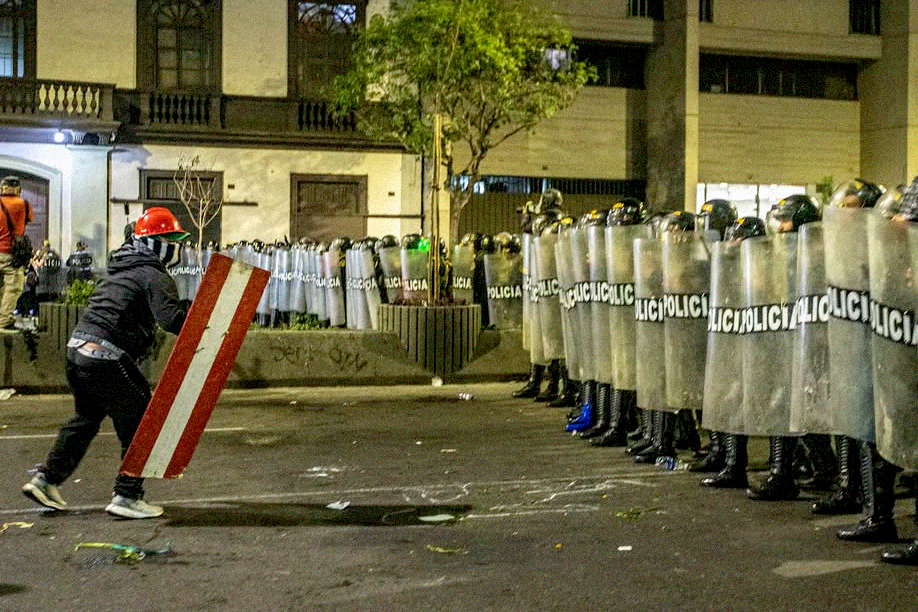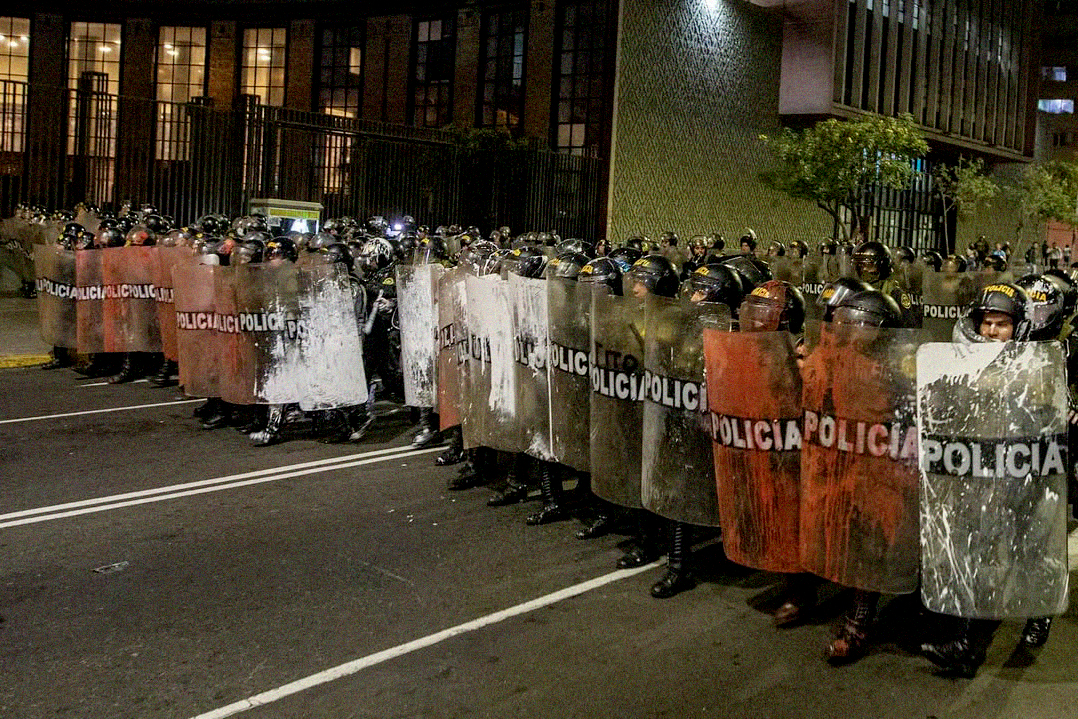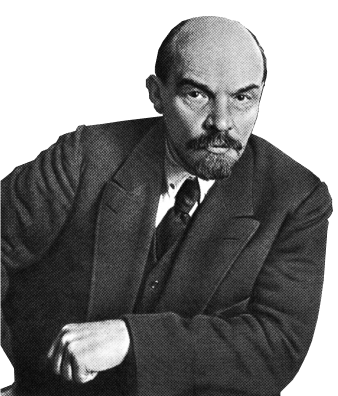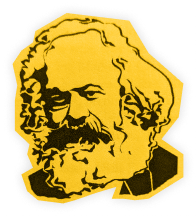
What began as youth protests against a pension counter-reform has quickly escalated into a political crisis of enormous proportions. Against a backdrop of rampant crime, persistent corruption and social unrest, the mass movement has forced the ousting of coup president Dina Boluarte. But the attempt to replace her from above, with the appointment of José Jerí, did not stop the protests. 15 October was a critical day: a protester named Eduardo Ruiz was killed by the police, and hundreds were injured.
The protests gained momentum in September 2025, with demonstrations led mainly by ‘Generation Z,’ who are particularly affected by the pension counter-reform. The example of mass youth protests in Asia, and particularly the burning of public institutions in Nepal, served as inspiration. Other sections of the oppressed soon joined the protests: trade unions, transport workers (particularly affected by insecurity), and students.
The reasons for the protests go beyond pension reform: the inability of the state to contain crime, rampant extortion, and the feeling that criminals enjoy widespread impunity were key triggers. The population’s perception is that both the government and Congress are part of organised crime, who engage in criminal and mafia activities. This perception is based on observable facts: the coup president, the government, and members of Congress are trying to line their pockets with public money.
One such example is Congress reinstating a bicameral system and enabling re-election without term-limits, despite these being rejected by 90 percent of the population in the 2018 referendum. This ‘reform’ was seen as a way for more ‘rats’ to enter the state, or to maintain their privileges by moving from one chamber to another, to steal more money and give themselves more privileges.
Added to this is the demand for justice for the more than 50 people killed in the repression of protests against the coup against President Pedro Castillo in December 2022, through which Boluarte consolidated her power. This is also the government that released [former dictator] Alberto Fujimori and enacted the amnesty law for police and military personnel who violated human rights during the dirty war.
The demonstrations began on 27 and 28 September. They were met with brutal police repression, with at least 19 people injured in Lima.
The marches, roadblocks and demonstrations in Lima and other regions denounced the government’s intransigence and the deterioration of living conditions. The protests reflect a crisis of legitimacy of the entire regime, which is expressed in one of the central slogans of the protests: ‘que se vayan todos’ (‘they must all go’). The attempt to grant concessions, by reforming the most offensive sections of the pension law, did not stop the movement.
On 8 October, a criminal attack on the cumbia group Agua Marina while they were performing at a recreation centre for non-commissioned army officers once again brought the issue of rampant criminal violence to the forefront of the political agenda. This incident was the spark that ignited the powder keg of anger and frustration among the people.
On 9 October, the presidential candidate of the right-wing Avanza País party, Phillip Butters, was the target of an attempted lynching during his election campaign visit to Puno, one of the regions hardest hit by repression during the protests against the 2022 coup. During the 2022 protests, Butters, without reason, blamed the victims and the population of Puno in general for causing unrest.
The expedited dismissal of Dina Boluarte
As outrage grew, members of Congress from different parties filed motions to remove Boluarte from office for ‘permanent moral incapacity,’ fuelled in part by scandals such as ‘Rolexgate,’ her abandoning her post to undergo cosmetic surgery, the doubling of her salary so that she could receive a higher presidential pension, and allegations of illicit enrichment. Dina ‘Balearte’ – trigger happy, as she was renamed by the rebellious people – was, due to her arrogant and contemptuous attitude, a constant insult to the broad masses of the population.
The idea was to get rid of the president, whose approval rating had become the lowest in the world, at just 2 percent (lower than the margin of error in the polls), in order to clean up the system’s image.
As in other countries caught up in the wave of the so-called ‘Gen Z revolution’, the corruption and ostentatious luxury of those at the top contrasts sharply with the general conditions of poverty, misery and lack of future prospects for those at the bottom. This is most acute among the generation that has grown up since the onset of the capitalist crisis in 2008.
In the early hours of 10 October 2025, the Congress of the Republic of Peru declared the presidency vacant with 124 votes in favour, with no abstentions or votes against – an unusual political gesture given the breadth of cross-party support. Boluarte, who did not attend the debate or present a defence before the plenary, was declared removed under the constitutional provision of ‘permanent moral incapacity’.
This manoeuvre bears certain similarities to when Martín Vizcarra was vacated from the presidency in 2020, which sparked massive protests by young people in Lima against the inauguration of Manuel Merino as his successor. Even then, there was deep dissatisfaction with the entire political establishment, and the masses rejected a top-down solution to the political crisis.
Had Boluarte not been removed from office, popular anger might have overthrown her.
The difference with the situation in 2020 is the approaching 2026 elections, for which election campaigns have already begun. In this context, Dina Boluarte became a useful scapegoat, the ronsoco (capybara – the world’s largest rodent) covering up the corruption and criminality of the other rats.
It is more convenient from the perspective of the criminals in Congress to start the campaign by making it seem as if they always wanted to remove Dina and finally succeeded, when in reality the vast majority of them are accomplices.
Rejection of the new president
With the Presidency vacant and with no vice presidents available, the Constitution establishes that the president of Congress assumes the presidency of the Republic. Thus, José Enrique Jerí Oré, until then the head of Parliament, was sworn in as interim president in the early hours of 10 October.
Jerí, 38, a lawyer by profession and leader of the ‘Somos Perú’ party, went from presiding over Congress (since July 2025) to assuming the leadership of the executive branch. In his inaugural speech, he promised ‘reconciliation,’ a transitional government, and a declaration of ‘war on crime.’
It would have been difficult to find another candidate less qualified to resolve a crisis of legitimacy of bourgeois institutions. Jerí has a history of sexual assault (dismissed by the attorney general) and several allegations (pending) of illicit enrichment and irregular payments.
The removal of Boluarte and the appointment of such a discredited figure as Jerí, rather than extinguishing the social flames, have only fanned them.
On 15 October, as part of a new call for a national strike, thousands marched through the streets of Lima, once again facing the huge and brutal repressive police apparatus. The police were prepared to use all means at their disposal to prevent the protesters from reaching the presidential palace, for fear they would burn it down.
During the clashes, a plainclothes police officer (terna) killed 31-year-old hip hop artist Eduardo Mauricio Ruiz Sanz, known artistically as ‘Trvko’, who belonged to a cultural collective in the San Martín de Porres district of Lima. Another protester is in serious condition and dozens of protesters were injured by pellets, tear gas, etc. On that day, the forces of repression were particularly harsh to journalists.
In 2020, President Merino immediately faced a wave of protests. His repression left two young people dead and his mandate collapsed in just five days. Jerí could go the same way.
Lessons for the movement
The protest movement in Peru has shown its bravery, courage in the face of repression and persistence, with demonstrations that have lasted for almost a month. It has hastened the departure of the hated Boluarte. But so far it does not have the strength to bring down the entire regime.
To move forward, it is necessary to learn the lessons of recent experiences, both from the mobilisations against corruption in 2020 and the election of Pedro Castillo’s government, as well as from the mass resistance against the coup in 2022-23.
Firstly, it is crucial to understand that corruption is not accidental, but is inherent to all capitalist regimes. It exists in countries dominated by imperialism, with weak and parasitic bourgeoisie, such as Peru, but also in ‘advanced’ capitalist countries such as Spain, Britain and the US, where lobbying, bribery and the awarding of contracts to the close circle of ministers and politicians is also commonplace.
The demand for a ‘clean’ government is in direct contradiction with the very existence of the capitalist system itself.
The government of Pedro Castillo (2021-22), elected by the working-class and peasant masses of rural and indigenous Peru, who longed for a substantial change in their living conditions through control of natural resources (gas and mining), also contains important lessons.

The main lesson is that the capitalist oligarchy will not allow its power, property or privileges to be touched in the slightest. Any attempt to moderate your programme to please them only serves to demoralise the masses, demobilise them and thus pave the way for disaster. Castillo’s electoral slogan ‘no more poor people in a rich country’ could only be achieved through a head-on confrontation with the owners of the country.
Parliamentary struggle can and must be used, but always with an awareness of its limitations and as an auxiliary to the struggle of the masses in the streets.
The insurrectionary movement against the coup in 2022-23 also contains important lessons. The mass mobilisation went very far and at times challenged the power of the state throughout the south of the country. But it never managed to involve the working class as a whole, particularly in the capital. The leadership of the CGTP (Workers’ General Confederation of Peru) never had any intention of decisively mobilising the strength of the working class, particularly the miners. Calls were made, but they were intended to disguise the lack of a real mobilisation.
Now, the movement is stronger in the capital, although its main base remains the youth. The regions, both in the south and the north, remain largely on the sidelines, perhaps due to a historical resentment towards the capital, because every time they demonstrate, they feel that they are being ‘left alone’.
To overthrow the corrupt and rotten regime of the capitalist oligarchy and its political representatives (whether they be Fujimori supporters, the brutal and entrenched right wing, or the caviar-eating left who play into their hands), the broadest possible mobilisation of the working class and poor indigenous peasantry is necessary.
To achieve this, a programme that appeals to everyone is necessary. The slogans of the moment are:
- Shut down the rat-infested Congress – They must all go!
- Revolutionary Constituent Assembly, with elected representatives from factories, neighbourhoods, schools and peasant organisations.
- Peace, work and land.
- Expropriation of the capitalist oligarchy and renationalisation of natural resources.
And to achieve this:
- A simultaneous nationwide strike and road blockades, until the oligarchy and its representatives fall.
- Organise committees of struggle from all sections of the oppressed in all regions, with national coordination.
- All power to the working people!

